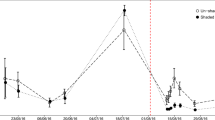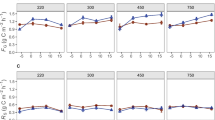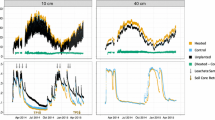Abstract
The release of root exudates into the rhizosphere is known to enhance soil biological activity and alter microbial community structure. To assess whether root exudates also stimulated litter decomposition, in a rhizosphere model system we continuously injected solutions of glucose, malate or glutamate through porous Rhizon® soil solution samplers into the soil at rhizosphere concentrations. The effect of these substances on the decomposition of 14C-labelled Lolium perenne shoot residues present in the soil was evaluated by monitoring 14CO2 evolution at either 15°C or 25°C. The incorporation of the 14C into the microbial biomass and appearance in the dissolved organic matter (DOM) pool was estimated after 32 d incubation. The presence of malate and glutamate increased the mineralization of L. perenne residues by approximately 20% relative to the soil without their addition at 15°C, however, no significant effects on residue decomposition were observed at 25°C. The incorporation of the 14C-label into the microbial biomass and DOM pool was not affected by the addition of either glucose, malate or glutamate. Although nearly the same amount of L. perenne residues were mineralized at either temperature after 32 d, less 14C was recovered in the microbial biomass and DOM pools at 25°C compared to 15°C. Alongside other results, this suggests that the rate of microbial turnover is greater at 25°C compared to 15°C. We conclude that the addition of labile root exudate components to the rhizosphere induced a small but significant increase on litter decomposition but that the magnitude of this effect was regulated by temperature.







Similar content being viewed by others
References
Atkinson D, Black KE, Forbes PJ, Hooker JE, Baddeley JA, Watson CA (2003) The influence of arbuscular mycorrhizal colonization and environment on root development in soil. Eur J Soil Sci 54:751–757
Bhupinderpal-Singh, Hedley MJ, Saggar S (2005) In situ dynamics of recently allocated 14C in pasture soil and soil solution collected with Rhizon Soil Moisture Samplers. Aust J Soil Res 43:659–666
Biasi C, Rusalimova O, Meyer H, Kaiser C, Wanek W, Barsukov P, Junger H, Richter A (2005) Temperature-dependent shift from labile to recalcitrant carbon sources of arctic heterotrophs. Rapid Commun Mass Spectrometr 19:1401–1408
Bodelier PLE, Wijlhuizen AG, Blom CWPM, Laanbroek HJ (1997) Effects of photo-period on growth of and denitrification by Pseudomonas chlororaphis in the root zone of Glyceria maxima, studied in a gnotobiotic microcosm. Plant Soil 190:91–103
Cheng W, Kuzyakov Y (2005) Root effects on soil organic matter decomposition. In: Wright S, Zobel R (eds) Roots and soil management: interactions between roots and the soil. Agronomy Monograph No. 48, American Society of Agronomy, Madison, Wisconsin, pp 119–143
Dakora FD, Phillips DA (2002) Root exudates as mediators of mineral acquisition in low-nutrient environments. Plant Soil 245:35–47
Darrah PR (1991) Measuring the diffusion-coefficient of rhizosphere exudates in soil. 1. The diffusion of non-sorbing compounds. J Soil Sci 42:413–420
De Nobili M, Contin M, Mondini C, Brookes PC (2001) Soil microbial biomass is triggered into activity by trace amounts of substrate. Soil Biol Biochem 33:1163–1170
Dijkstraa FA, Cheng W, Johnson DW (2006) Plant biomass influences rhizosphere priming effects on soil organic matter decomposition in two differently managed soils. Soil Biol Biochem 38:2519–2526
Dobermann A, Gaunt JL, Neue HU, Grant IF, Adviento MA, Pampolino MF (1994) Spatial and temporal variability of ammonium in flooded rice fields. Soil Sci Soc Am J 58:1708–1717
Domanski G, Kuzyakov Y, Siniakina SV, Stahr K (2001) Carbon flows in the rhizosphere of Lolium perenne. J Plant Nutr Soil Sci 164:381–387
Dormaar JF (1990) Effect of active roots on the decomposition of soil organic materials. Biol Fertility Soils 10:121–126
Farrar J, Hawes M, Jones D, Lindow S (2003) How roots control the flux of carbon to the rhizosphere. Ecology 84:827–837
Fontaine S, Bardoux G, Benest D, Verdier B, Mariotti A, Abbadie L (2004) Mechanisms of the priming effect in a savannah soil amended with cellulose. Soil Sci Soc Am J 68:125–131
Gielen B, Calfapietra C, Lukac M, Wittig VE, De Angelis P, Janssens IA, Moscatelli MC, Grego S, Cotrufo MF, Godbold DL, Hoosbeek MR, Long SP, Miglietta F, Polle A, Bernacchi CJ, Davey PA, Ceulemans R, Scarascia-Mugnozza GE (2005) Net carbon storage in a poplar plantation (POPFACE) after three years of free-air CO2 enrichment. Tree Physiol 25:1399–1408
Hamer U, Marschner B (2005a) Priming effects in different soil types induced by fructose, alanine, oxalic acid and catechol additions. Soil Biol Biochem 37:445–454
Hamer U, Marschner B (2005b) Priming effects in soils after combined and repeated substrate additions. Geoderma 128:38–51
Hinsinger P, Plassard C, Jaillard B, Tang CX (2003) Origins of root-mediated pH changes in the rhizosphere and their responses to environmental constraints: a review. Plant Soil 248:43–59
Hütsch BW, Augustin J, Merbach W (2002) Plant rhizodeposition – an important source for carbon turnover in soils. J Plant Nutr Soil Sci 165:397–408
Jaeger CH, Lindow SE, Miller S, Clark E, Firestone MK (1999) Mapping of sugar and amino acid availability in soil around roots with bacterial sensors of sucrose and tryptophan. Appl Environ Microbiol 65:2685–2690
Jones DL (1998) Organic acids in the rhizosphere – a critical review. Plant Soil 205:25–44
Jones DL, Darrah PR (1993) Re-sorption of organic compounds by roots of Zea mays L. and its consequences in the rhizosphere. II. Experimental and model evidence for simultaneous exudation and re-sorption of soluble C compounds. Plant Soil 153:47–59
Jones DL, Darrah PR (1994) Simple method for 14C labeling root material for use in root decomposition studies. Commun Soil Sci Plant Anal 25:2737–2743
Jones DL, Willett VB (2006) Experimental evaluation of methods to quantify dissolved organic nitrogen (DON) and dissolved organic carbon (DOC) in soil. Soil Biol Biochem 38:991–999
Jones DL, Farrar J, Giller KE (2003) Associative nitrogen fixation and root exudation – What is theoretically possible in the rhizosphere? Symbiosis 35:19–38
Jones DL, Hodge A, Kuzyakov Y (2004a) Plant and mycorrhizal regulation of rhizodeposition. New Phytol 163:459–480
Jones DL, Shannon D, Murphy DV, Farrar J (2004b) Role of dissolved organic nitrogen (DON) in soil N cycling in grassland soils. Soil Biol Biochem 36:749–756
Kim TK, Silk WK (1999) A mathematical model for pH patterns in the rhizospheres of growth zones. Plant Cell Environ 22:1527–1538
Kraffczyk I, Trolldenier G, Beringer H (1984) Soluble root exudates of maize: influence of potassium supply and rhizosphere microorganisms. Soil Biol Biochem 16:315–322
Kuzyakov Y (2002) Review: factors affecting rhizosphere priming effects. J Plant Nutr Soil Sci 165:382–396
Kuzyakov Y, Bol R (2006) Sources and mechanisms of priming effect induced in two grassland soils amended with slurry and sugar. Soil Biol Biochem 38:747–758
Kuzyakov Y, Friedel JK, Stahr K (2000) Review of mechanisms and quantification of priming effects. Soil Biol Biochem 32:1485–1498
Lecompte F, Ozier-Lafontaine H, Pages L (2001) The relationships between static and dynamic variables in the description of root growth. Consequences for field interpretation of rooting variability. Plant Soil 236:19–31
Michel K, Matzner E (2002) Nitrogen content of forest floor Oa layers affects carbon pathways and nitrogen mineralization. Soil Biol Biochem 34:1807–1813
Neumann G, Römheld V (1999) Root excretion of carboxylic acids and protons in phosphorus-deficient plants. Plant Soil 211:121–130
Parnas H (1976) A theoretical explanation of the priming effect based on microbial growth with two limited substrates. Soil Biol Biochem 8:139–144
Pietikainen J, Pettersson M, Bååth E (2005) Comparison of temperature effects on soil respiration and bacterial and fungal growth rates. FEMS Microbial Ecol 52:49–58
Poorter H, Bergkotte M (1992) Chemical-composition of 24 wild-species differing in relative growth-rate. Plant Cell Environ 15:221–229
Sowerby A, Emmett B, Beier C, Tietema A, Penuelas J, Estiarte M, van Meeteren MJM, Hughes S, Freeman C (2005) Microbial community changes in heathland soil communities along a geographical gradient: interaction with climate change manipulations. Soil Biol Biochem 37:1805–1813
Van Kessel C, Nitschelm J, Horwath WR, Harris D, Walley F, Luscher A, Hartwig U (2000) Carbon-13 input and turn-over in a pasture soil exposed to long-term elevated atmospheric CO2. Global Change Biol 6:123–135
Vance ED, Brookes PC, Jenkinson DS (1987) An extraction method for measuring soil microbial biomass C. Soil Biol Biochem 19:703–707
Waldrop MP, Firestone MK 2004 Altered utilization patterns of young and old soil C by microorganisms caused by temperature shifts and N additions. Biogeochemistry 67:235–248
de Weert S, Vermeiren H, Mulders IHM, Kuiper I, Hendrickx N, Bloemberg GV, Vanderleyden J, De Mot R, Lugtenberg BJJ (2002) Flagella-driven chemotaxis towards exudate components is an important trait for tomato root colonization by Pseudomonas fluorescens. Mol Plant–Microbe Interact 15:1173–1180
Xie ZB, Cadisch G, Edwards G, Baggs EM, Blum H (2005) Carbon dynamics in a temperate grassland soil after 9 years exposure to elevated CO2 (Swiss FACE). Soil Biol Biochem 37:1387–1395
Zhang W, Parker KM, Luo Y, Wan S, Wallace LL, Hu S (2005) Soil microbial responses to experimental warming and clipping in a tallgrass prairie. Global Change Biol 11:266–277
Zogg GP, Zak DR, Ringelberg DB, MacDonald NW, Pregitzer KS, White DC (1997) Compositional and functional shifts in microbial communities due to soil warming. Soil Sci Soc Am J 61:475–481
Zyakun AM, Dilly O 2005 Use of carbon isotope composition for characterization of microbial activity in arable soils. Appl Biochem Microbiol 41:582–591
Acknowledgements
This work was funded by the UK Natural Environment Research Council and the British Council-Germany Academic Exchange Service (BC-DAAD). The German Research Foundation (DFG) is greatly acknowledged for financially supporting Yakov Kuzyakov.
Author information
Authors and Affiliations
Corresponding author
Rights and permissions
About this article
Cite this article
Kuzyakov, Y., Hill, P.W. & Jones, D.L. Root exudate components change litter decomposition in a simulated rhizosphere depending on temperature. Plant Soil 290, 293–305 (2007). https://doi.org/10.1007/s11104-006-9162-8
Received:
Accepted:
Published:
Issue Date:
DOI: https://doi.org/10.1007/s11104-006-9162-8




